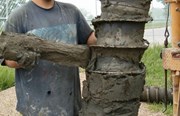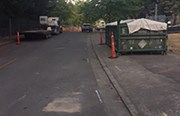RFP 101: How to Build an Effective Request for Proposal, 2023 Update
By: Eliot CooperWhat is a Request for Proposal?
Investopedia defines an RFP “as a business document that announces and provides details about a project, as well as solicits bids from contractors who will help complete the project.”
For remediation, the “project” is the cleanup of a contaminated site, typically with both soil and groundwater contamination. The “details” of the project help the contractor develop a remediation approach and include the site description and statement of work (SOW). “Complete” refers to meeting remediation objectives over a specified timeline, which can range from long-term monitored natural attenuation (MNA) and institutional controls all the way to achieving safe groundwater standards.
An RFP should have several objectives, with some of the most frequent ones being:
- Informing potential contractors or suppliers that you’re looking for a product or service and asking them to put together a competitive proposal.
- Describe the product or service you need with enough detail for contractors and vendors to know whether they are qualified to bid.
- Letting bidders know if there is a competitive selection process and if you’re interested in a lump sum or time-and-materials payment structure.
- Providing evaluation and selection criteria, when possible, to help contractors align their proposals with your project goals.
- Setting expectations about the bidding process, expected format of proposals, timeline for decision-making, and required contract details.
To accomplish this laundry list of goals, important information is needed in the form of the site description, a statement of work (SOW), and a section explaining to contractors how proposals will be evaluated. If there are any non-negotiable contract clauses or payment terms for the project, those also must be included in the RFP.
What should an effective In Situ Remediation RFP Contain?
As mentioned above, an RFP typically contains two important sections: the site description and the statement of work (SOW). A third and equally important section explains to contractors what they need to do to present a bid. This includes guidance to bidders about how to prepare a proposal as well as how qualifying proposals will be evaluated. Our pre-mobilization checklist provides an in-depth view of the moving parts that need to be addressed to ensure a smooth and time-efficient project. If there are any non-negotiable contract clauses or payment terms for the project, those also must be included in the RFP. This site evaluation form is a good example of what an in-situ remediation contractor will need from you to provide you with the best price on your next job.
What should a site description include?
The site description is a key component of the RFP and defines the conditions the bidder will encounter on the project site. This is the most important aspect of an RFP. It is also a potential source of confusion due to lack of information. In most cases where change orders are initiated by the successful bidder, variation between actual versus described site conditions are the root cause.
A complete site description should include:
- Site map delineating treatment area and specified square footage
- Site photos if site walk is not offered
- Treatment interval(s)
- Representative well log(s), blow counts, and depth to groundwater, seasonal groundwater elevation changes
- Above or below-ground utilities or other logistical issues
- If remedial design support is required, e.g. dosing and delivery approach, include:
- Conceptual site model (CSM) including contaminant concentrations in NAPL, soil, soil gas and groundwater phases
- High resolution site characterization (HRSC) logs and reports if performed
- Previous remediation events, outcomes, and reports
- Groundwater geochemistry
- Hydraulic conductivity of target intervals
- Groundwater seepage velocity and flow direction
- Remediation objectives and timelines
- Post injection performance monitoring approach
What should a statement of work include?
A statement of work section documents the expectations you have of the winning bidder once work begins. It’s important for this to be clearly outlined in the RFP so contractors understand exactly what they need to price out and estimate for you.
The statement of work should include:
- Number of injection locations and new performance monitoring well locations
- Delivery approach, e.g. direct push and/or well injection
- Distribution verification requirements and ramifications if not achieved
- Amendments pounds and diluted solution to be injected
- Injection flowrate and pressure restrictions
- Dilution water availability and pretreatment requirements
- Injection amendment sequencing
- Who purchases amendments?
- Required equipment specifications, e.g. pumps, drill rigs, mixing systems
- Unique site logistics that can impact remediation performance, e.g. traffic control, manifold optimization restrictions, site and injection location access
- Injection documentation and reporting requirements
- Health and safety documentation and reporting
Apart from the site description and statement of work mentioned in the RFP, the skills and expertise of the bidding parties should also be assessed. Their past projects should involve comparable lithology, target interval depths, injection equipment, and amendments. Additionally, it is crucial to consider the qualifications and experience of the bidder's design and field implementation team. Jump into the four things you need to ask every contractor before hiring.
Remember, a robust RFP is not just a document; it's a comprehensive roadmap that navigates the complex terrain of remediation projects, driving them toward successful, on-budget, and timely completion. The fruits of this meticulous labor, like a well-woven tapestry, are not just rewarding but leave a lasting legacy of successful environmental stewardship.
Take a deep dive into the RFP Process in the webinar “Can Your RFP Influence In Situ Groundwater Remediation Costs and Results?”.
If you’d like to learn more about how you can improve your RFP skills, watch our webinar on-demand to master the art of RFPs.
About the Author

Vice President, Technology and Business Development
Eliot Cooper is the Vice President of Technology and Business Development. In this role, he helps clients design efficient and cost-effective remedies using high resolution site characterization (HRSC) and a vast array of remediation options. His specialty is finding the right combination of tools and technologies for complex sites, and ensuring every step of the remediation process is optimized to achieve results. He is currently applying this experience to the new world of PFAS Characterization and Remediation.












